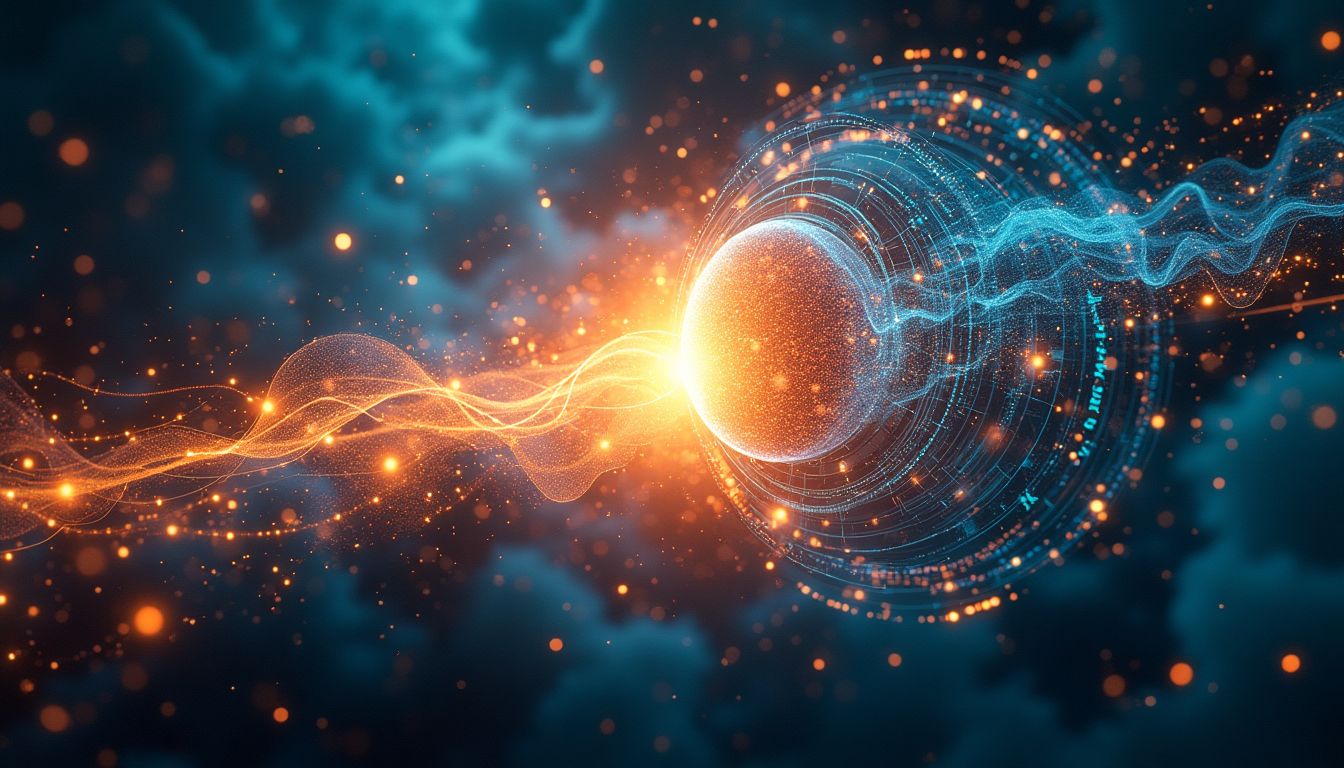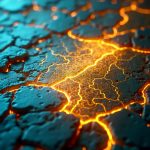What if the key to unlocking infinite, clean energy has been hiding in plain sight—not in a lab, but in the algorithms of artificial intelligence? For decades, nuclear fusion has been the ultimate "almost there" technology, promising to revolutionize energy production by mimicking the sun's power. Yet, despite billions of dollars and countless hours of research, fusion has remained tantalizingly out of reach. Enter AI, the digital wizard that might just crack the code. From predicting plasma behavior to optimizing reactor designs, AI is breathing new life into the quest for fusion power. And if you think this sounds like science fiction, you're not alone. Even luminaries like Stephen Hawking once mused that fusion could be humanity's salvation—if we could just figure it out. Now, with AI in the mix, that "if" is starting to look a lot smaller.
Fusion isn't just a scientific curiosity; it's a potential game-changer for our planet. As Bill Nye often points out, the climate crisis demands bold solutions, and fusion could be the ultimate clean energy source. But let's not forget the skeptics. Elon Musk, ever the provocateur, has called fusion "the ultimate pie in the sky." Yet, even he acknowledges that breakthroughs in AI could tip the scales. So, is fusion finally within our grasp? And if so, what role will AI play in making it a reality? Buckle up—this is where the story gets interesting.
1. The Promise of Fusion Power: Why It Matters
1.1 The Science of Fusion
At its core, nuclear fusion is about smashing atoms together to release energy—lots of it. Specifically, it involves combining light atomic nuclei, like hydrogen isotopes (deuterium and tritium), to form heavier elements. This process releases a staggering amount of energy, far more than traditional nuclear fission, which splits atoms apart. Think of it as the difference between a controlled campfire (fission) and a roaring bonfire (fusion). The sun, our cosmic neighbor, has been running on fusion for billions of years. So why can't we?
Well, replicating the sun's conditions on Earth is no small feat. Fusion requires temperatures of over 100 million degrees Celsius—hotter than the sun's core—and pressures that would make a black hole blush. Oh, and you need to keep the plasma (a superheated, electrically charged gas) stable long enough for fusion to occur. It's like trying to contain a lightning bolt in a bottle. But here's the kicker: if we can pull it off, fusion offers a virtually limitless energy source with minimal environmental impact. No greenhouse gases, no radioactive waste—just clean, abundant power.
1.2 The Energy Crisis and Climate Change
Let's face it: our current energy system is a ticking time bomb. Fossil fuels are finite, dirty, and increasingly expensive. Meanwhile, renewable energy sources like solar and wind, while promising, can't yet meet global demand. Enter fusion, the ultimate clean energy solution. According to the International Energy Agency, global energy demand is expected to grow by 50% by 2050. Without a breakthrough, we're headed for a perfect storm of energy shortages and environmental catastrophe.
Fusion could change all that. By harnessing the same process that powers the sun, we could generate enough energy to power the planet for millions of years. And unlike fossil fuels, fusion produces no carbon emissions. It's like swapping out a gas-guzzling clunker for a sleek, solar-powered sports car. But here's the catch: we're not there yet. Despite decades of research, fusion remains elusive. That's where AI comes in.
1.3 Historical Challenges
Fusion research has a long and storied history, filled with breakthroughs, setbacks, and the occasional "Eureka!" moment. One of the earliest attempts was the tokamak, a donut-shaped device designed to contain plasma using powerful magnetic fields. Developed in the 1950s by Soviet scientists, the tokamak remains one of the most promising approaches to fusion. But it's not without its challenges.
For starters, maintaining plasma stability is incredibly difficult. Even the slightest disturbance can cause the plasma to collapse, halting the fusion process. Then there's the issue of energy efficiency. To date, no fusion experiment has achieved a net energy gain—meaning the energy output exceeds the energy input. It's like trying to run a marathon on a single granola bar. Finally, there's the problem of materials. The extreme heat and radiation inside a fusion reactor can destroy even the toughest materials. It's a bit like trying to build a car that can survive a trip through a volcano.
Despite these challenges, fusion researchers remain optimistic. And with AI now in the mix, that optimism is starting to feel a lot more justified. But more on that later.
2. The Role of AI in Scientific Discovery
2.1 AI as a Problem-Solving Tool
Artificial intelligence isn’t just for chatbots and self-driving cars. It’s a Swiss Army knife for solving complex problems. Think of AI as the Sherlock Holmes of science—except it doesn’t need a deerstalker hat or a pipe to crack cases. AI excels at spotting patterns, optimizing systems, and making predictions faster than a caffeinated physicist. For example, AI has already revolutionized fields like drug discovery and climate modeling. If it can predict hurricanes and design life-saving drugs, why not use it to tame the sun’s power?
2.2 AI in Fusion Research
Fusion research is like trying to bottle a star. It’s messy, unpredictable, and requires a lot of trial and error. Enter AI, the ultimate lab assistant. At facilities like ITER and MIT’s SPARC, AI is helping scientists optimize magnetic fields, predict plasma behavior, and even design reactor components. Private companies like Helion Energy are also jumping on the AI bandwagon, using machine learning to accelerate their fusion experiments. It’s like giving scientists a cheat code for the universe’s most complicated video game.
2.3 The Synergy of AI and Fusion
AI doesn’t replace human scientists—it supercharges them. Imagine a scientist and an AI working together like Batman and Robin. The scientist brings creativity and intuition, while the AI crunches numbers and spots trends faster than you can say “E=mc².” This dynamic duo is already uncovering solutions that might have taken decades to discover otherwise. For instance, AI has helped identify new plasma confinement strategies that could make fusion reactors more efficient. It’s like finding a shortcut in a maze that no one even knew existed.
3. Key Challenges in Fusion and How AI Can Help
3.1 Plasma Instability
Plasma is the diva of the fusion world. It’s hot, unpredictable, and refuses to stay in one place. Maintaining stable plasma at temperatures hotter than the sun’s core is no small feat. But AI is stepping up as the ultimate plasma whisperer. By analyzing real-time data from fusion experiments, AI can predict and control plasma instabilities before they spiral out of control. It’s like having a weather forecast for plasma storms—except instead of rain, you get a reactor meltdown.
3.2 Energy Efficiency
Fusion’s ultimate goal is to produce more energy than it consumes—a concept known as net energy gain (Q > 1). So far, this has been as elusive as a unicorn. But AI is helping scientists optimize reactor designs to squeeze every last drop of energy out of the fusion process. For example, AI algorithms can tweak the shape of magnetic fields or adjust the timing of energy pulses to maximize efficiency. It’s like tuning a guitar, except the strings are made of plasma and the stakes are the future of humanity.
3.3 Material Science
Fusion reactors are like the Iron Man suits of energy production—they need materials that can withstand extreme heat and radiation. Unfortunately, most materials melt faster than an ice cream cone in July. AI is stepping in to help design new alloys and composites that can survive the harsh conditions inside a reactor. By simulating material behavior and testing thousands of combinations, AI is accelerating the search for the perfect fusion armor. It’s like a high-tech blacksmith, forging the tools we need to harness the stars.
4. Breakthroughs Enabled by AI
4.1 AI-Optimized Reactor Designs
One of the most exciting breakthroughs in fusion research has been the use of AI to optimize reactor designs. Traditional approaches to designing fusion reactors, like tokamaks and stellarators, have relied heavily on trial and error. But AI is changing the game by simulating millions of design variations in a fraction of the time. For example, researchers at MIT used machine learning to tweak the magnetic fields in their SPARC reactor, achieving better plasma confinement with less energy input. This kind of optimization could slash the time and cost of building commercial fusion reactors.
AI is also helping to refine the geometry of reactors. Tokamaks, which use a donut-shaped magnetic field to contain plasma, have long been the gold standard. But AI is now enabling the design of more efficient stellarators, which have a twisted, complex shape that was previously too difficult to model. Companies like Helion Energy are leveraging AI to create compact, modular reactors that could bring fusion power to remote areas.
4.2 Predictive Modeling
Predicting how plasma will behave inside a reactor is one of the biggest challenges in fusion research. Plasma is notoriously unstable, and even small fluctuations can disrupt the fusion process. AI is stepping in to tackle this problem by using neural networks to simulate plasma behavior under different conditions. For instance, scientists at the ITER project have developed AI models that can predict plasma instabilities milliseconds before they occur, allowing for real-time adjustments.
These predictive models are also helping researchers understand the complex interactions between plasma and magnetic fields. By analyzing vast amounts of data from past experiments, AI can identify patterns that humans might miss. This has led to breakthroughs like the discovery of "quasi-symmetry" in stellarators, a property that makes them more stable and efficient.
4.3 Collaborative AI Systems
Fusion research is a global effort, with experiments taking place in facilities around the world. AI is playing a key role in integrating data from these diverse sources, enabling scientists to collaborate more effectively. For example, the EUROfusion consortium uses AI to combine data from tokamaks in Europe, the U.S., and Asia. This shared knowledge base accelerates progress by allowing researchers to build on each other's work.
AI is also facilitating international partnerships. The DeepMind team, known for its work on AI and gaming, has partnered with fusion researchers to develop algorithms that optimize reactor performance. These collaborations are breaking down silos and fostering innovation on a global scale.
5. The Future of AI-Driven Fusion
5.1 Scaling Up
As AI helps us overcome the technical challenges of fusion, the next step is scaling up from experimental reactors to commercial power plants. This transition will require significant investment and infrastructure, but AI can make it more manageable. For example, AI can optimize the design of power plants to minimize costs and maximize efficiency. It can also streamline the manufacturing process for reactor components, reducing the time it takes to bring fusion power online.
One promising approach is the development of modular reactors, which can be built in factories and shipped to their final destination. Companies like Commonwealth Fusion Systems are already working on this concept, using AI to design compact, high-performance reactors that could be deployed in urban areas.
5.2 Ethical and Societal Implications
While the potential benefits of fusion power are enormous, there are also ethical and societal considerations to address. For one, we need to ensure that fusion energy is accessible to all, not just wealthy nations. AI can help by reducing the cost of fusion technology, but policymakers will need to create frameworks that promote equitable access.
There are also concerns about the role of AI in scientific decision-making. While AI can process data faster than humans, it lacks the ability to make value judgments. This raises questions about who should be in control of AI-driven fusion research. Should it be scientists, governments, or private companies? These are complex issues that will require careful consideration as we move forward.
5.3 The Road Ahead
So, when can we expect fusion power to become a reality? Estimates vary, but many experts believe that AI could help us achieve commercial fusion within the next 10-20 years. Projects like ITER and SPARC are making steady progress, and private companies are pushing the boundaries of what's possible. With AI on our side, the dream of limitless, clean energy is closer than ever.
But the journey doesn't end there. AI has the potential to unlock entirely new approaches to fusion, from advanced plasma confinement techniques to novel fuel sources. The possibilities are endless, and the stakes couldn't be higher. As we stand on the brink of a new energy era, one thing is clear: AI is the key to cracking the code for infinite energy.
6. AI Solutions: How Would AI Tackle This Issue?
6.1 Data Collection and Integration
The first step in leveraging AI for fusion power is to aggregate and integrate data from fusion experiments worldwide. Facilities like ITER, JET, and the National Ignition Facility (NIF) generate vast amounts of data on plasma behavior, magnetic fields, and energy output. AI can sift through this data to identify patterns and correlations that might be invisible to human researchers. For instance, machine learning algorithms can analyze decades of experimental data to pinpoint the conditions most likely to result in stable plasma confinement.
6.2 Predictive Modeling
Once the data is collected, the next step is to develop predictive models using neural networks. These models can simulate fusion reactions under various conditions, helping researchers predict outcomes before conducting expensive and time-consuming experiments. For example, AI-driven simulations at MIT’s Plasma Science and Fusion Center have already shown promise in predicting plasma instabilities. By training these models on historical data, scientists can refine their predictions and reduce the risk of experimental failures.
6.3 Real-Time Optimization
AI can also play a crucial role in real-time optimization of fusion reactors. By implementing AI systems to monitor and adjust reactor parameters in real time, researchers can maintain optimal conditions for plasma confinement. Reinforcement learning algorithms, which improve through trial and error, can be used to fine-tune magnetic fields and energy input. This approach has been successfully tested at Max Planck Institute for Plasma Physics, where AI systems have demonstrated the ability to stabilize plasma for longer durations.
6.4 Material Discovery
Another critical area where AI can make a difference is in material science. Fusion reactors require materials that can withstand extreme heat and radiation, and AI can accelerate the discovery of such materials. By simulating material behavior and identifying new alloys, AI can help researchers develop components that are more durable and efficient. Collaborations between AI experts and material science labs, such as those at Lawrence Berkeley National Laboratory, are already yielding promising results.
6.5 Collaborative Innovation
Finally, AI can foster collaborative innovation by creating a global platform for fusion research. By enabling scientists to share insights and solutions, AI can break down silos and accelerate progress. Initiatives like the EUROfusion Consortium are already leveraging AI to integrate data from multiple experiments and facilities. This collaborative approach can help researchers identify common challenges and develop unified solutions.
Actions Schedule/Roadmap (Day 1 to Year 2)
Day 1: Assemble a task force of AI and fusion experts from institutions like MIT, Princeton University, ITER, and DeepMind.
Day 2: Begin data aggregation from major fusion experiments, including JET, NIF, and Max Planck Institute.
Week 1: Develop a unified data platform for fusion research, integrating data from all participating institutions.
Week 2: Train initial AI models on historical fusion data to identify patterns and correlations.
Month 1: Launch predictive modeling initiatives for plasma behavior, using neural networks to simulate fusion reactions.
Month 2: Begin real-time optimization experiments in test reactors, using reinforcement learning to fine-tune reactor parameters.
Year 1: Achieve breakthroughs in plasma stability and energy efficiency, demonstrating the potential for net energy gain.
Year 1.5: Test AI-designed materials in experimental reactors, focusing on durability and radiation resistance.
Year 2: Demonstrate net energy gain in an AI-optimized reactor, marking a significant milestone in the quest for sustainable fusion power.
A Future Powered by AI and Fusion
Imagine a world where energy is no longer a scarce resource, where the air is clean, and the threat of climate change is a distant memory. This is the future that AI-driven fusion power promises. By harnessing the power of artificial intelligence, we can overcome the technical challenges that have stymied fusion research for decades. From optimizing plasma containment to discovering new materials, AI is revolutionizing the way we approach one of humanity’s greatest challenges.
But the journey is far from over. As we stand on the brink of a new era in energy production, we must continue to invest in AI and fusion research. The roadmap outlined above provides a clear path forward, but it will require collaboration, innovation, and a shared commitment to a sustainable future. The stakes are high, but the rewards are even higher. Together, we can crack the code for infinite energy and create a world where everyone has access to clean, abundant power.
What role will you play in this transformative journey? Will you be a pioneer, pushing the boundaries of what’s possible? Or will you be a supporter, helping to spread the word and drive progress? Whatever your role, the time to act is now. The future of energy is in our hands, and with AI as our ally, there’s no limit to what we can achieve.
Join the conversation and share your thoughts in the comments below. And don’t forget to subscribe to our newsletter to stay updated on the latest developments in AI and fusion power. Together, we can build a brighter, cleaner future for generations to come.
FAQ
1. What is nuclear fusion?
Nuclear fusion is the process of combining light atomic nuclei, like hydrogen isotopes, to release massive amounts of energy. It’s the same process that powers the sun and stars. Unlike nuclear fission, which splits heavy atoms like uranium, fusion is cleaner, safer, and uses abundant fuel sources like deuterium and tritium. For more on the science, check out this explanation from ITER.
2. Why is fusion so difficult to achieve?
Fusion requires extreme conditions—temperatures over 100 million degrees Celsius and immense pressure—to force atomic nuclei together. Controlling the superheated plasma (a state of matter where atoms are stripped of electrons) is incredibly challenging. Plasma is unstable and can escape containment, making it hard to sustain the reaction. Learn more about the challenges from Princeton Plasma Physics Laboratory.
3. How can AI help with fusion?
AI is a game-changer for fusion research. It can:
- Optimize magnetic fields to contain plasma more effectively.
- Predict plasma behavior using advanced simulations.
- Design better reactor components by analyzing vast amounts of data.
For example, DeepMind has already used AI to solve complex scientific problems, and similar techniques are being applied to fusion. Check out how MIT is using AI in fusion research.
4. When will fusion power become a reality?
Estimates vary, but many experts believe fusion could become commercially viable within the next 10-20 years, thanks to AI. Projects like ITER and private ventures like Helion Energy are making significant progress. AI is accelerating these efforts by solving problems faster than ever before.
5. What are the risks of using AI in fusion research?
While AI is incredibly powerful, it’s not perfect. Over-reliance on AI could lead to errors if the models aren’t properly trained or if they overlook critical factors. However, human oversight and collaboration between AI experts and fusion scientists can mitigate these risks. For a deeper dive into the ethics of AI in science, read this article from Nature.
6. What’s the difference between fusion and fission?
Fusion combines light atoms to release energy, while fission splits heavy atoms. Fusion produces no long-lived radioactive waste and uses fuels that are abundant in nature, like deuterium from seawater. Fission, on the other hand, generates radioactive waste and relies on scarce materials like uranium. Learn more about the differences from the U.S. Department of Energy.
7. Who is leading the charge in fusion research?
Several organizations are at the forefront of fusion research:
- ITER: A global collaboration building the world’s largest fusion reactor in France.
- Helion Energy: A private company working on compact fusion reactors.
- MIT: Developing the SPARC reactor with AI-driven designs.
These efforts are complemented by AI research from organizations like DeepMind and IBM.
8. How does fusion help fight climate change?
Fusion produces no greenhouse gases and uses fuels that are virtually inexhaustible. If successful, it could replace fossil fuels and provide a clean, sustainable energy source for the planet. For more on how fusion fits into the fight against climate change, read this article from the International Atomic Energy Agency (IAEA).
9. What role does AI play in material science for fusion?
Fusion reactors require materials that can withstand extreme heat and radiation. AI helps by:
- Simulating how materials behave under fusion conditions.
- Identifying new alloys and composites that are more durable.
For example, Oak Ridge National Laboratory is using AI to develop advanced materials for fusion reactors.
10. Can I get involved in fusion research?
Absolutely! Many universities and organizations offer opportunities for students and professionals to contribute to fusion research. Check out programs at Princeton University, MIT, and ITER. You can also explore AI-driven fusion projects with companies like Helion Energy.
11. What’s the biggest breakthrough in fusion so far?
One of the most significant breakthroughs was achieving a net energy gain (Q > 1) in experiments like those at the Lawrence Livermore National Laboratory. This means the reaction produced more energy than it consumed, a critical milestone for fusion power. AI is now helping to replicate and scale these results.
12. How does AI predict plasma behavior?
AI uses machine learning to analyze data from past experiments and predict how plasma will behave under different conditions. For instance, DeepMind has developed neural networks that can simulate plasma dynamics with incredible accuracy. This helps researchers optimize reactor designs and avoid costly trial-and-error experiments.
13. What’s the cost of developing fusion power?
Fusion research is expensive, with projects like ITER costing billions of dollars. However, AI is helping to reduce costs by speeding up experiments and improving efficiency. Over time, the investment could pay off with a virtually limitless energy source.
14. Will fusion energy be affordable for everyone?
The goal is to make fusion energy affordable and accessible worldwide. While initial costs may be high, advancements in technology and economies of scale could bring prices down. Organizations like IAEA are working to ensure that fusion benefits all of humanity, not just wealthy nations.
15. What’s next for AI and fusion?
The future is bright! AI is expected to play an even bigger role in:
- Scaling up experimental reactors to commercial power plants.
- Discovering new materials and designs for more efficient reactors.
- Enabling global collaboration through shared AI platforms.
Stay tuned for updates from leading projects like ITER and Helion Energy.
Wait! There's more...check out our gripping short story that continues the journey: Fathoms Deep
Disclaimer: This article may contain affiliate links. If you click on these links and make a purchase, we may receive a commission at no additional cost to you. Our recommendations and reviews are always independent and objective, aiming to provide you with the best information and resources.
Get Exclusive Stories, Photos, Art & Offers - Subscribe Today!





























Post Comment
You must be logged in to post a comment.